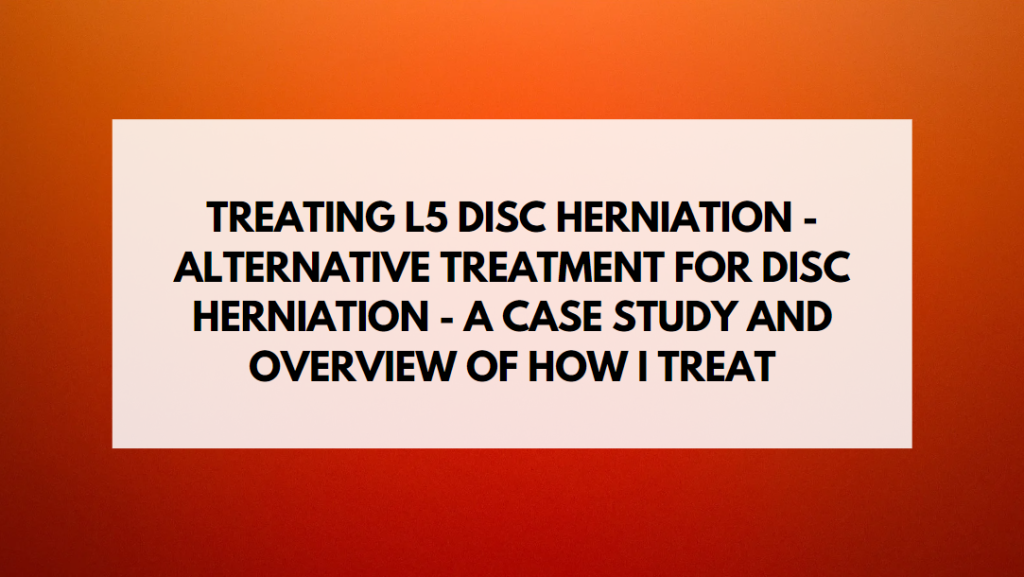This week I saw a patient for a L5/S1 disc bulge who had already been to multiple orthopedic doctors who performed a lot of useless injections that didn’t help his pain in any way. These big orthopedic practices had hit a wall in figuring out this patients symptoms. Let me walk you through what I did differently and how this approach can help you with your L5 Disc Herniation get the care you need to actually get out of pain!
I see L5 disc herniation cases on a literally daily basis – the vast majority of back pain happens in a small square that’s about 5 inches x 5 inches. When you know what to look for – these “tricky” cases aren’t that tricky and can be treated without drugs or surgery using advanced dry needling.
Quick Overview of This Case
So this patient is a 36 year old male had backpain for years and eventually it got so bad he went to an orthopedic doctor who did an x-ray that showed nothing and an MRI that showed a herniation a L5 / S1. The standard of care for a disc herniation is to prescribe a 7 day steroid pack and recommend physical therapy for 8-12 weeks where you go 3 times a week. If that doesn’t work then you get an epidural steroid injection.
This patient did both and was still in the same amount of pain. Then he started having tightness in his ribs and armpit – which frankly stumped his doctors.
So they started throwing spaghetti at the wall to see what would stick. He received an SI joint cortisone injection – which did nothing.
It didn’t help that this patient had a lot of pain even in his ribs and armpits – which was really throwing off his doctors and they eventually ordered a thoracic MRI – which showed nothing.
So he was left with a lot of pain still, and his doctors were stumped and out of options.
Cue the google searches and eventually finding me – Dr. Josh Hanson, DACM in Tampa, FL :).
The correct diagnosis requires listening…
It’s crazy – if you simply give a patient space and listen well, they will always tell you exactly what’s going on and narrow in your diagnosis. But unfortunately most doctors will interrupt you after 30 seconds and just railroad you into getting more imaging without listening to what you’re saying. All in the span of a 7 minute visit that doesn’t even include a throrough physical exam. No wonder you can go months or years with chronic pain and feel like every treatment you receive doesn’t help. (Okay I’m stepping off my soapbox now).
So I simply listened to this patient and where he described his pain and other symptoms.
He had numbness in the bottom of his foot, pain in his low back, tightness on the side of his ribs and even under his arm on the affected side.
This information really helped me zero in on what was causing his pain and develop a thorough and comprehensive treatment plan with Interventional Dry Needling (an advanced dry needling treatment approach that the physical therapist down the road didn’t learn in their short weekend course – a topic I’ve covered in other articles).
What Are the Symptoms of an L5-S1 Disc Bulge or Herniation?
Here’s what this patient told me – which is all related to L5-S1 disc bulge symptoms – it could be the text book!
- Numbness in the leg that goes to the big toe or the bottom of the foot The L5 nerve goes to the big toe and the S1 nerve goes to the bottom of the foot. If a herniation irritates these either of these nerves (or both) then you will have symptoms like numbness, tingling, a heavy feeling like someone wrapped a towel around your leg or even a zinging lightning bolt sensation.
- Pain, tightness, heaviness in the hamstrings, side of the leg, and calf. These are all muscles or areas connected to muscles (like the iliotibial band or ITB) that connect back up to the S1 nerve.
A simple physical exam can really help to correlate an MRI with what’s actually going on – in fact this is essential. You see if you took an MRI of anyone over the age of 40 years old (even if they have no pain) – there’s a 50% chance it will show herniations, bulges, degeneration and basically everything else that sounds bad – EVEN IF THERE IS NO PAIN. So that means these changes are normal as we age, and it doesn’t mean you have to have pain or that your pain is even associated with the findings on imaging. (PMID: 25430861)
- When I pushed on his vertebrae on an exam, the only one that causes pain is L5-S1.
So his back is telling me that this L5-S1 disc herniation is causing his problem.
What Happens When an Epidural Doesn’t Work?
This patient had hit a wall with conventional orthopedic doctors – they had done an epidural and it didn’t work. Then he got new pain in his ribs and armpit which really just puzzled his doctors. When he found me – I wasn’t even a little bit surprised, I’ve seen this exact pattern of back pain hundreds of times!
When you have an L5-S1 disc bulge or herniation, that irritates the local L5 or S1 spinal nerves. Some parts of these nerves go down the leg causing sciatica. However, other parts head back toward the spine and tell the local multifidus muscles what to do. These muscles are deep spinal stabilizers that are critical for keeping the spine bones aligned while you move.
Long-term nerve irritation of our spinal nerves can and will cause atrophy (shrinking) or the deep multifidus muscles PMID: 27590444.
What happens next is predictable.
The multifidus get weak and shrink, then your low back gets unstable because the job of the multifidus is to stabilize your spine. So your body starts to use the bigger more superficial low back muscles more and tighten everything down to create stability. When this happens you feel tightness and back spasm. These big back muscles are not designed to stay tight for long periods of time so eventually they get worn out and the tendons get really stressed out and painful. When this happens your latissimus dorsi kicks in and tries to tighten down and create stability (hence the rib and armpit tightness and pain in this patient).
The big spine muscle was causing his problem? It’s called the iliocostalis lumborum, but along with that the latissimus dorsi can also kick in to tighten things down as it actually attaches to our lumbar vertebrae (shown below).


This is why he felt pain and tightness from his back to the back part of his ribs and even armpit.
This was to be expected due to the multifidus atrophy that was clearly seen on his MRI but not read out by the reading radiologist.
This is why his doctors ordered a completely unnecessary thoracic MRI that just cost him a thousand dollars and didn’t provide any valuable insight or better approach to treatment.
How Do You Treat L5-S1 Disc Herniation?
There are a few things that we need to target and we can do all of this with specialized interventional dry needling. This is an advanced dry needling technique and process that your regular physical therapist likely doesn’t have the training to perform.
(Remember a physical therapist who performs dry needling is only required to take a 52 hour weekend course to legally do dry needling – as opposed to the 3,000+ hands on hours an acupuncturist has). So make sure you make sure the practitioner you choose has the proper training and also experience. I’ve performed over 30,000 procedures and have likely seen your exact type of back pain.
First we need to treat the irritated spinal nerves – which is called the medial branch. We can target this while we are also treating your multifidus which will help to create stability.

Then we will target the superficial back muscles and latissimus dorsi to help to relax them.
When we restore function to the irritated nerves and help clean them out along with relaxing the tight back muscles with dry needling you get significant pain relief and long term changes in your pain levels.
Most patients will need a series of treatments over the course of a few weeks to restore function and calm down these irritated tissues.
The good news
Even if you have herniations and bulges that send your doctors on a wild goose chase there is hope that your back pain can be treated without drugs or surgery. It just takes understanding the biomechanics of what’s actually happening and also having the skill to treat the problem. If you have a herniation or bulge at L5/S1 there is hope and I am confident that I can likely help your case.





